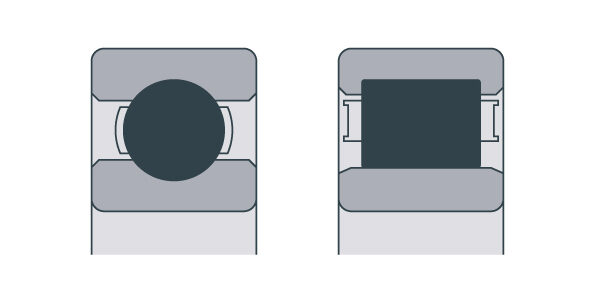Description
Voltage between the rotor and the stator particularly occurs in AC electric motors that are run by means of frequency converters. These charges are passed to the shaft in a capacitive manner. This voltage is shorted by the motor bearings in the instant when the dielectric characteristics of the bearing greases are overcome. The current emerging in this process leads to spark erosion (EDM) with high temperatures which significantly affect the quality of the lubricating grease, and consequently cause damage to the raceways and rolling elements. Damage includes, among other things, incipient fusion of the contact surfaces of the roller elements and raceways, pitting, and formation of ripples/ corrugated elements. Initial indicators of the occurrence of these phenomena are increased bearing noise and vibrations, and they result in early failure of the bearing.
SLF offers various current-insulating bearings. The current-insulation effect derives from the aluminum oxide-ceramic coating on the outer contour of the outer or inner ring; the bearings are available with voltage resistance in the 500 V, 1000 V, and 3000 V classes. SLF hybrid bearings with ceramic rolling elements (silicon nitride) provide the best insulation effect thanks to their outstandingly high electrical resistance values of up to 1012 Ohm.
Electrical insulation between the housing and the shaft prevents this damage.
One solution is to coat the outer or inner ring with an insulating layer (suffix J20A..) at SLF.


Alternatively, rolling elements made of ceramic can be used. They are more often used for smaller roller bearings.

Coated roller bearings with suffix J20A..
Roller bearings with an electrically insulating coating are coated on the outer or inner surface (diameter) and on both faces. A nonconducting oxide ceramic coating is plasma-sprayed onto the surface.
The thicker the coating, the better the protection against electrical voltage.
The insulating layer is dimensioned so that the dielectric strength is guaranteed up to
- 500V (J20A) and
- 1000V (J20A1)
- 3000V (J20A3)
D.C. voltage when mounted.
Suffix
| Symbol/ abbrev. | Description |
| J20A | Bearing with current-insulating coating The outer ring is coated with a nonconducting cemented oxide ceramic coating – dielectric strength up to 500V. |
| J20AB | Bearing with current-insulating coating The inner ring is coated with a nonconducting cemented oxide ceramic coating – dielectric strength up to 500V. |
| J20A1 | Bearing with current-insulating coating The outer ring is coated with a nonconducting cemented oxide ceramic coating – dielectric strength up to 1000V. |
| J20A1B | Bearing with current-insulating coating The outer ring is coated with a nonconducting cemented oxide ceramic coating – dielectric strength up to 1000V. |
Characteristics
| J20A(B) | J20A1(B) | |
| Dielectric strength voltage, D.C. | 500V | 1000V |
| Minimum coating thickness outer diameter | 70µm | 140µm |
| Minimum coating thickness outer diameter | 60µm | 120µm |
| Range of dimensions outer diameter D | 70mm to 400mm | 70mm to 400mm |
The bearing’s main dimensions and tolerances (outer diameter, bore diameter, and width) match those of an uncoated bearing.
They can be used instead of uncoated bearings without additional measures.
During mounting, impacts and shocks to the ceramic coating must be avoided.
Rolling elements made of ceramic (hybrid bearings)
In hybrid bearings, rolling elements made of ceramic (silicon nitride) are responsible for current insulation. They provide the greatest resistance to current flow.
Moreover, they have running characteristics beneficial for most of applications:
- Higher speed
- The same dynamic load rating, about 30% less static load rating
- Less friction
- Better emergency running parameters
- More efficient lubrication use
- Less weight
- Higher bearing stiffness
Prefix
| Symbol/ abbrev. | Description |
| C | Rolling elements made of ceramic rather than steel – such as in deep groove ball bearings, angular contact ball bearings and cylindrical roller bearings (Bsp. C6208; C7210B; CNU206E) |
| HC | Rolling elements made of ceramic rather than steel – such as in spindle bearings and high precision cylindrical roller bearings (Example: HCB71907C; HC7012E; HCN1008) |
Comparison between steel and ceramic – material data
| Steel ball | Ceramic ball | |
| Material | 100Cr6 | Si3N4silicon nitride |
| Resistivity in Ω * mm2/m |
0,22 | 1010 … 1016 |
| Density in g/cm³ |
7,8 | 3,2 |
| Young’s modulus in N/mm² |
210.000 | 300.000 |
| Hardness | 150 – 700 HV10 | 1300 – 1500 HV10 |
| Thermal conductivity in W/(m*K) |
45 | 29 |
| Thermal conductivity in 1/(106*K) |
12 | 2,9 |